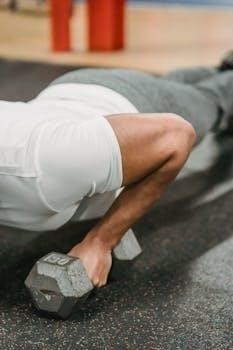Resistance band workouts offer a versatile and effective way to build strength and improve fitness․
They are portable, affordable, and can be used for a variety of exercises․
These bands provide variable resistance throughout the range of motion, engaging muscles more effectively․
Ideal for all fitness levels, resistance bands are a great alternative to traditional weights․
Benefits of Resistance Band Training
Resistance band training offers a multitude of benefits, making it an excellent choice for individuals of all fitness levels․
Firstly, resistance bands are incredibly versatile, allowing for a wide range of exercises targeting various muscle groups․
Their portability makes them perfect for travel or home workouts, eliminating the need for bulky equipment․
Moreover, resistance bands are gentle on the joints, reducing the risk of injury compared to traditional weightlifting․
They provide variable resistance, challenging muscles throughout the entire range of motion, leading to improved strength and muscle tone․
Resistance band training also enhances flexibility and mobility, promoting better overall physical function․
Additionally, resistance bands are an affordable fitness option, making them accessible to everyone․
They are also effective for rehabilitation purposes, aiding in recovery from injuries and improving muscle imbalances․
Resistance band workouts can be easily modified to suit individual fitness levels and goals, ensuring a personalized and effective training experience․
Furthermore, they can be used to increase the intensity of bodyweight exercises, providing an extra challenge for advanced fitness enthusiasts․
Lastly, resistance band training promotes core stability and balance, contributing to improved posture and reduced risk of falls․

Types of Resistance Bands
Resistance bands come in various forms, each suited for different exercises and fitness levels․
Loop bands are continuous circles, ideal for lower body workouts․
Tube bands with handles offer a secure grip for upper body exercises․
Flat bands are versatile for assisted stretches and light resistance․
Resistance Loop Bands
Resistance loop bands, also known as mini bands, are a popular and versatile type of resistance band․ Characterized by their continuous loop design, they offer a convenient and effective way to target various muscle groups, particularly in the lower body․ Their compact size makes them ideal for travel and home workouts․
These bands are commonly used for exercises like squats, glute bridges, and lateral walks, providing resistance that enhances muscle activation and strength development․ The level of resistance varies depending on the band’s thickness, allowing users to progress gradually as they get stronger․
Resistance loop bands are also a great tool for rehabilitation and physical therapy, as they offer low-impact resistance that helps to improve joint stability and muscle function․ They are easy to incorporate into existing workout routines, adding an extra challenge to bodyweight exercises․
The portability and affordability of resistance loop bands make them a must-have for anyone looking to enhance their fitness routine․ They are a simple yet effective way to add resistance training to any workout, whether at home, in the gym, or on the go․ These loops are truly beneficial for a dynamic workout!
Resistance Tubes with Handles
Resistance tubes with handles offer a unique and versatile approach to resistance training, providing a comfortable grip and enhanced exercise options․ These tubes are designed with handles at each end, allowing for a secure and ergonomic hold during workouts․
The handles enable a greater range of motion and exercise variations compared to loop bands, making them suitable for upper body exercises like bicep curls, tricep extensions, and rows․ The resistance levels of the tubes vary, catering to different fitness levels and exercise goals․
These tubes are also excellent for full-body workouts, targeting major muscle groups with controlled movements․ The added handles make it easier to maintain proper form and reduce the risk of injury․ Resistance tubes with handles are also beneficial for physical therapy and rehabilitation, offering a gentle and effective way to rebuild strength and improve mobility․
Their portability and ease of use make them a convenient option for home workouts and travel․ Whether you’re a beginner or an experienced fitness enthusiast, resistance tubes with handles can add a new dimension to your training regimen․ They offer a fantastic way to engage the muscles!

Full Body Resistance Band Workout Plan
A full body resistance band workout plan effectively targets all major muscle groups․ Utilizing various resistance band exercises, this plan enhances strength, endurance, and flexibility․ Consistent training with this plan promotes overall fitness and well-being, making it a convenient option․
Warm-up Exercises
Prior to starting any resistance band workout, a proper warm-up is crucial to prepare your muscles and joints, reducing the risk of injury; Dynamic stretches and light cardio exercises are ideal components of an effective warm-up routine․ Incorporate movements that mimic the exercises you’ll be performing during the main workout, but at a lower intensity․
Start with arm circles, both forward and backward, to loosen the shoulder joints․ Follow with leg swings, both forward and sideways, to activate the hip flexors and hamstrings․ Bodyweight squats and lunges can also be performed to further engage the lower body muscles․
Resistance band-specific warm-up exercises include band pulls, where you hold the band with both hands and pull it apart, engaging the back and shoulder muscles․ Band rotations, where you twist your torso while holding the band, can help improve core mobility․ These exercises enhance blood flow and increase muscle temperature, preparing your body for the workout ahead․ Remember to focus on controlled movements and proper form throughout the warm-up to maximize its benefits and minimize the risk of strain․
Cool-down and Stretching
After completing your resistance band workout, a cool-down and stretching routine is essential for muscle recovery and flexibility improvement․ This helps reduce muscle soreness and promotes overall well-being․ Begin with light cardio, such as walking or gentle cycling, for about five to ten minutes to gradually lower your heart rate․
Follow this with static stretches, holding each stretch for 20-30 seconds․ Focus on the muscle groups you worked during the workout, such as the chest, back, legs, and glutes․ Examples include chest stretches by interlacing your fingers behind your back and gently lifting your arms, hamstring stretches by touching your toes, and quad stretches by pulling your heel towards your glutes․
Additionally, incorporate stretches that target the shoulder and hip muscles to improve joint mobility․ Deep breathing during each stretch can enhance relaxation and promote better circulation․ Remember to avoid bouncing during stretches, as this can increase the risk of injury․ Consistent cool-down and stretching routines will contribute to long-term fitness and flexibility gains․

Upper Body Resistance Band Exercises
Resistance bands provide an excellent tool for sculpting and strengthening the upper body․
Target chest, back, shoulders, and arms with varied exercises․
Banded chest presses, rows, and bicep curls offer effective muscle engagement․
Adjust resistance levels to match your fitness goals․
Chest Exercises with Resistance Bands
Resistance bands offer a versatile and effective way to target chest muscles, whether you’re at home or traveling; These exercises provide a comprehensive workout, engaging different parts of the chest for balanced development․ The key benefit of using resistance bands lies in their ability to provide consistent tension throughout the entire range of motion, maximizing muscle activation and growth․ Chest exercises with resistance bands can easily be modified to suit different fitness levels, ensuring that everyone can benefit from this type of training․
One popular exercise is the resistance band chest press, which mimics the traditional dumbbell bench press․ By anchoring the band behind your back and pressing forward, you can effectively target the pectoral muscles․ Another effective exercise is the resistance band chest fly, which helps to isolate and shape the chest muscles․ This exercise is particularly useful for improving chest definition and enhancing overall upper body strength․ Incorporating these resistance band chest exercises into your routine can lead to significant improvements in chest strength and muscle tone, without the need for heavy weights․
Back Exercises with Resistance Bands
Resistance bands are an excellent tool for strengthening your back muscles, offering a convenient and effective workout solution at home or on the go․ These exercises not only build strength but also improve posture and reduce back pain, making them an essential part of any fitness routine․ The unique benefit of using resistance bands is their ability to provide constant tension throughout the exercise, engaging your back muscles more effectively than traditional weights might․ Back exercises with resistance bands are easily adaptable to various fitness levels, ensuring that everyone can benefit from this versatile training method․
One of the most effective back exercises with resistance bands is the seated row․ By looping the band around your feet and pulling towards your torso, you can target your lats and rhomboids․ Another great exercise is the resistance band pull-apart, which focuses on strengthening the upper back and improving shoulder stability․ This exercise involves holding the band with both hands and pulling it apart, engaging the muscles between your shoulder blades․ Incorporating these resistance band back exercises into your workout routine can lead to significant improvements in back strength, posture, and overall upper body health․

Lower Body Resistance Band Exercises
Resistance bands are fantastic for lower body workouts, offering a joint-friendly way to build strength․
They enhance exercises like squats and lunges, targeting glutes, quads, and hamstrings effectively․
Portable and versatile, resistance bands are ideal for home or travel workouts․
Leg Workouts with Resistance Bands
Resistance bands are an excellent tool for enhancing leg workouts, providing a versatile and effective way to build strength and tone muscles․
They offer a progressive resistance that challenges your muscles throughout the entire range of motion, leading to improved strength and definition․
Exercises like banded squats, lunges, and glute bridges can be amplified with resistance bands, targeting key muscle groups such as the quads, hamstrings, and glutes․
These exercises not only build strength but also improve stability and balance, reducing the risk of injury․
Banded leg workouts are also a fantastic way to improve posture and mobility․
Resistance bands can be easily incorporated into your existing workout routine, adding an extra layer of challenge and variety․
Whether you’re a beginner or an experienced fitness enthusiast, resistance bands can be tailored to suit your fitness level․
By adjusting the band’s resistance, you can progressively increase the intensity of your workouts as you get stronger․
Additionally, resistance bands are lightweight and portable, making them ideal for home workouts, travel, or adding a boost to your gym routine․
With the right exercises and consistent effort, resistance band leg workouts can help you achieve a stronger, more toned lower body․
Glute Exercises with Resistance Bands
Resistance bands are incredibly effective for targeting and sculpting your glutes, offering a versatile and convenient way to enhance your workouts․
These bands provide constant tension throughout each exercise, maximizing muscle activation and promoting glute growth․
Exercises like banded hip thrusts, glute bridges, and lateral walks become even more challenging and effective with the addition of resistance bands․
The added resistance forces your glutes to work harder, leading to improved strength, definition, and overall glute development․
Resistance bands also allow for a greater range of motion and control during exercises, ensuring that you’re targeting the correct muscles and preventing injury․
Whether you’re a beginner or an experienced lifter, resistance bands can be easily incorporated into your routine to increase the intensity of your glute workouts․
Exercises such as kickbacks and clamshells can be modified to add a resistance band, challenging the glutes and other muscles․
These exercises help to improve hip stability and overall lower body strength․
Furthermore, resistance bands are portable and affordable, making them an ideal choice for home workouts or travel․
With consistent use and proper form, resistance band glute exercises can help you achieve a stronger, more toned, and well-rounded lower body․